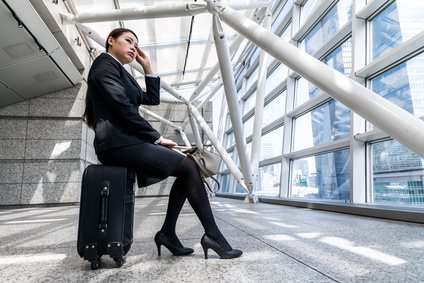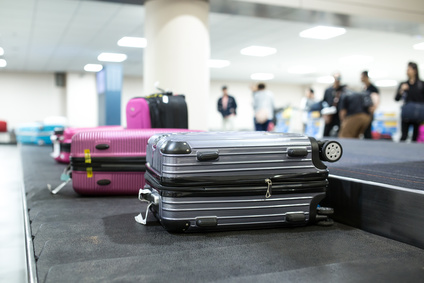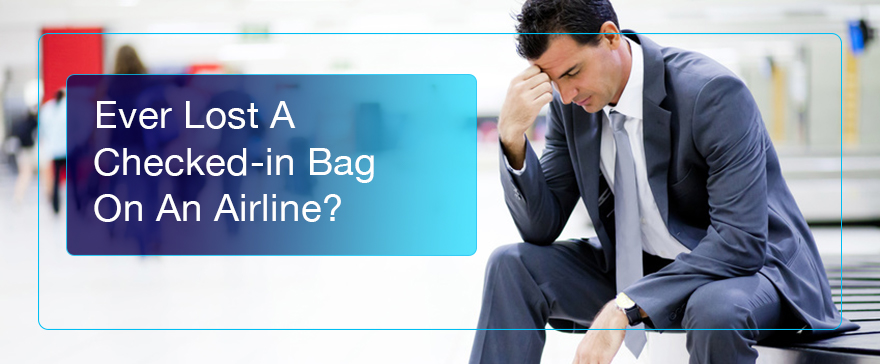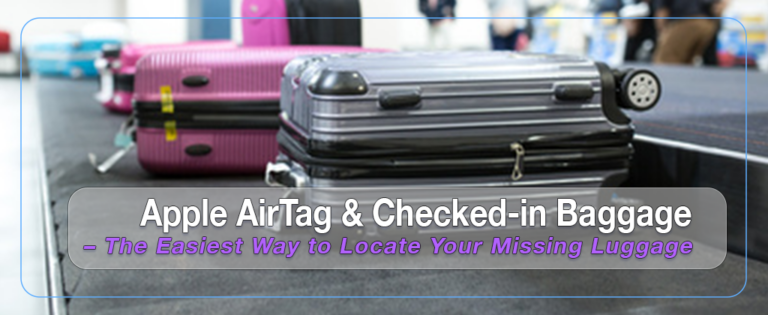Every now and then, checked baggage seem to develop a mind of their own to go off on a jaunt. The truant piece of luggage, decides to take a route different from that of its owner. What was destined for Medicine Hat, Alberta could end up in Melbourne, Australia; or in Dublin, Ireland, instead of Dubai in the UAE. A lost checked-in bag can become a painful experience. It is one of those happenings that comes with air travel. There often is no rhyme or reason for the phenomenon. 2017 saw 4.08 Billion Air travellers; 22.7 Million bags were mishandled. Fortunately, 78% of all mishandled bags were only delayed; not lost.
How Do Bags Get Lost?
In the old days, the check-in agent at the airport had to hand-write baggage tags. Some agents checked a manual if they were not too sure. Others thought they knew it all and erroneously sent your baggage to Timbuktu. Thankfully, those days are over.
Today, it is a computer that prints out your Baggage Tag. Sorting of checked baggage is also done by computers through a network of several kilometres of chutes and belts beneath a modern airport. Occasionally a sensor reads a tag incorrectly and sends off the baggage to the wrong aeroplane.
The most common reason for baggage not arriving on the carousel is insufficient connecting time. If you are making a connection to get to your destination (with your baggage through-checked), it would be good to give yourself about 90 minutes at the very least to make the connection. There are airports that may need more time. Many passengers try to make a connection in one hour. The passenger may make the connection, but baggage most often does not. It will often arrive on the next flight; but that may be too late for that important business meeting you had scheduled. You would have created the problem yourself.
Tracing Lost Checked-in Bags

If you only see the last few bags on the carousel, yours is not among them and your anxiety levels start to rise, the chances are your baggage has been “mishandled” – to use an airline term. What should you do? Look for any airline staff of the airline you arrived on, who may be on duty in the baggage area.
If you don’t find one, you could ask the airport staff who are on duty. They may be empowered to handle the situation or will call for an airline staff to come to the baggage area. It is important to have a Property Irregularity Report (PIR), made out. It is a simple form that needs to be completed. Many Airlines will fill up the form on a computer and give the passenger a print-out. Do not leave the baggage area without your PIR.
The PIR number is what will reconnect the lost checked-in bag to its owner. It is advisable to request the airline to deliver the baggage to your hotel or home. All airlines do it as part of the lost baggage recovery service. When things go wrong with checked baggage, the Airline can only prove its efficiency by tracing the lost baggage and returning it to its owner in the shortest possible time.
If the errant baggage has the airline check-in tag which could identify the correct destination of the baggage, staff could put the information into the Lost Baggage Tracking System and link up the ‘find’ with the ‘loss’ and send it on its way to the owner.
Immediate needs
As per International Air Transport Association (IATA) regulations, the Airline is obligated to provide the passenger the means to cope with ‘first necessities.” Basic needs: a toilet kit and a change of clothes.
Many airlines will just provide the passenger with a certain sum of money, for them to buy the items. If you however, have to go out and buy a suit to attend that important meeting, do preserve your bills and receipts to make an insurance claim. This is one area where Travel Insurance comes in handy.
Airlines are also obligated to reimburse the passenger; it however is easier to deal with a good Insurance company. Do remember that airline regulations for compensation is almost always by the weight of the checked-in baggage. They have a fixed rate for every kilogram or pound lost.
Double dipping, is not allowed; you either claim through the Insurance Company or through the Airline.
If Your Baggage Arrives Damaged
Be sure to check your baggage before you leave the baggage area. If there is any damage, it may be necessary to go through the Property Irregularity Report process to report the damage.
Usually, an airline will offer to repair the damage, or if the item cannot be repaired, they will replace the suitcase with a similar item – you may not however be given the same brand!
What To Do if Items Inside Your Checked Baggage Go missing?
Pilferage has been controlled and to a great extent minimised. It has not been totally eliminated and does occasionally happen.
I know of a case where a passenger was forced to change his dates of travel and itinerary due to floods in the South Indian city of Chennai. After a few involuntary changes to his itinerary, he eventually arrived into India, on a well-known British Airline (not the airline he was originally booked on); but his baggage did not arrive. It was delivered to his home a few days later. When he opened it, all the items he had bought during his trip abroad had disappeared.
He took up the matter with the Airline who in turn blamed Transport Security Administration TSA (his return journey had originated in the USA). To quote the Airline, “As your bag was checked by TSA with a note confirming the same, I’m afraid that we are not liable for any claim.” He received nothing from TSA as well.
Some airlines behave as if compensation completely comes out of their own pockets. All airlines are insured for baggage mishandling and/or loss. This example was an extraordinary situation: delayed baggage linked to pilferage.
Normally, if you arrive at an airport and had a few expensive items in your checked baggage, it may be a good idea to open the suitcase and check before you leave the baggage area of the airport.
If anything is missing you could have a PIR created. Once that is done you could claim compensation. Do please note that you cannot make that report once you have left the arrival baggage area and cleared customs.
How is the Lost Checked-in Bag returned to its owner?
While creating the Property Irregularity Report, the traveller will have to provide delivery address details.
It could be a hotel or home address in the same city or another city within the country. If the traveller is leaving the city soon, then the next possible delivery address should be provided.
It is the responsibility of the airline concerned, to deliver the baggage to the owner at the airline’s cost. They had an obligation to deliver the checked-in baggage along with the same flight the passenger arrived on. If they didn’t it is entirely their responsibility to find the lost checked-in bag and deliver it.
What you can do to minimise the chances of losing your baggage

The most important thing to do to prevent baggage loss is to ensure your checked baggage is name-tagged properly and also has a name and address label on the inside. Do include a telephone number and email address.
If the airline’s check-in tag has come off for some reason, baggage staff will check for the passenger’s name and address tag.
If that is not found on the bag, airline staff may have the baggage opened to check for an address, inside the case. If that is also missing they can only try to match it to the owner’s description.
Alas, today there are millions of bags that look alike. Finding a lost bag, by colour, brand, size and description is often impossible.
Some Tips to Mitigate Lost Checked-in Bags
- Remove all old airline tags from your baggage, including bar code stickers that may be stuck to any part of the luggage.
- Ensure your name and address tag is strong and can withstand the journey and airport baggage processes. Please write in a telephone number and email address.
- Ensure there is a name and address tag on the inside.
- Avoid trying to make tight connections.
- Avoid last-minute check-in. Everyone is in a hurry at that time including Airline staff who have a responsibility for on-time departures.
- Make a list of the contents of your baggage and carry them in your carry-on luggage – just in case your baggage does get lost. I have witnessed passengers trying to remember what was in their lost checked-in bag. One just cannot remember everything in that situation.
- Do not pack documents or jewellery in your baggage to be checked in. Always carry such items in your carry-on bag.
- Carry a change of clothes in your carry-on luggage.
- Travel Insurance is always advisable.
Looking ahead to the future
The last couple of years have seen a drop in the number of bags lost per 1000 air travellers. It indicates that airlines are getting better at handling our baggage. The International Air Transport Association (IATA) Resolution 753 came into effect in 2018. As a result, the industry is expected to see increased baggage tracking capabilities on the part of member airlines.
One of the best solutions to the baggage loss problem is probably the RFID – Radio Frequency Identity tag. People and Airlines are already beginning to successfully use them. The tiny device can be embedded in the baggage or bag-tag. Tracing through the RFID is a piece of cake! May your precious baggage never get lost.
Airline Lost Baggage FAQs
What should I do when my baggage does not arrive on the conveyor belt?
The traveller should look for an officer of the airline you arrived on in the Baggage Arrivals section, or a Lost Baggage section, to make a formal complaint.
Can I leave the baggage area and return to file my complaint?
No. It is imperative that the complaint is made before you leave the Baggage Arrivals area. No claim will usually be entertained after you have left the Arrivals area.
What is a PIR? Is it important to get one?
A PIR in the Airline Travel industry language is a Property Irregularity Report. It is a document the passenger receives when a missing or damaged baggage complaint is made. One should not leave the arrival area without a PIR if the traveller has had any issues with checked-in baggage.
What are my rights when my baggage does not arrive on the same aeroplane as I did?
When an airline does not deliver checked-in baggage as contracted, it has an obligation to take care of the immediate needs of the passenger as per IATA regulations. They are basically toiletries and a change of clothes; items that would normally have arrived with checked-in baggage.
Do I need to pay for the baggage to be delivered to my destination address?
The traveller can notify the Airline (part of the PIR process), the address to which the found baggage should be delivered in the city. If they are travelling to another city, within the country or abroad, they could leave flight and delivery address details. It is the responsibility of the airline to deliver the baggage at their cost. They lost your baggage. They will have to pay.
© Mano Chandra Dhas
Note – Share your thoughts below. I will respond to all comments. Use the social media buttons to share this post with others who might find it useful. Please subscribe to never miss an update!



